Top Links
Journal of Case Reports and Studies
ISSN: 2348-9820
Primary Angiitis of the Central Nervous System a Riddle, Wrapped in a Mystery, inside an Enigma
Copyright: © 2016 C. Canepa-Raggio. This is an open-access article distributed under the terms of the Creative Commons Attribution License, which permits unrestricted use, distribution, and reproduction in any medium, provided the original author and source are credited.
Related article at Pubmed, Google Scholar
54-year-old gentleman with a previous medical history consistent of recurrent headaches, hypertension, dilated cardiomyopathy, hypercholesterolemia and recurrent renal calculi. Over a one-year period, he gradually developed worsening headaches associated with intermittent blurred vision, generalized aches and pains, mild cognitive impairment, and several episodes of focal upper and lower limb weakness. These symptoms led to several evaluations in the A&E and EADU, one evaluation in the TIA clinic, two admissions to the stroke ward and several outpatient reviews in our stroke, neurology and rheumatology clinic. He received a diagnosis of temporal arteritis in the TIA clinic and started to take steroids. He was then admitted to our stroke ward following a diagnosis of multi-territory brain infarctions (pontine stroke, corpus callosum and right centrum semiovale). Following discharge, he remained symptomatic and this led to several outpatients MRIs which revealed more ischemic events disseminated in time and place; however, due to an rather atypical ‘resolution’ of previous ischemic events, this led to the suspicion of a possible case of multiple sclerosis, leading to an lumbar puncture which ultimately was slightly abnormal but was not positive for oligoconal bands. In the meantime, all serologic investigations were negative for infectious, autoimmune and neoplastic causes. Finally, a CT-angiogram followed by a Digital Subtraction Angiogram (DSA) revealed – in comparison with a previous CTA – a considerable narrowing in both MCAs, leading to the diagnosis of primary angiitis of the central nervous system (PACNS). After IV methylprednisolone, the patient stabilized for a short period of time, only to have a large L-MCA stroke which required a decompressive hemicraniectomy; he remains globally aphasic with mild right upper limb weakness.
Keywords: Primary Angiitis; Transthoracic Echocardiogram; Oligoclonal Bands
List of Abbreviations: PACNS: Primary Angiitis of the Central Nervous System; CTA: Computed Tomography Angiogram; DSA: Digital Subtraction Angiogram; DCMP: Dilated Cardiomyopathy; S-ECHO: Stress Echocardiogram; TTE: Transthoracic Echocardiogram; RBBB: Right Bundle Branch Block; MCA: Middle Cerebral Artery; OCB: Oligoclonal Bands; TIA: Transient Ischemic Attack; GSA: Giant Cell Arteritis
54-year-old gentleman with a previous medical history characterized by recurrent bi-frontal and bi-temporal headaches, mild hypertension, hypercholesterolemia and recurrent renal calculi.
Approximately one year before his final diagnosis, he started to present a gradual onset of shortness of breath, mainly exacerbated by moderate exertion, accompanied by occasional chest pain. As these symptoms worsened over the following weeks, a Transthoracic Echocardiogram (TTE) was requested, revealing signs of a Dilated Cardiomyopathy (DCMP). A Stress Echocardiogram (S-ECHO) was subsequently performed without signs of reversible ischemia and with good contractile reserve in lateral, inferior, anterior and posterior walls. He was then given treatment with Bisoprolol and GTN spray to use as required.
One month after, due to persisting headaches associated with intermittent bilateral blurred vision, flue-like symptoms, generalized aches, night sweats and jaw pain, he attended the AE. A CT head and CT-angiogram (CTA) was done without signs neither of ischemia, haemorrhage nor of carotid or middle cerebral artery (MCA)/anterior cerebral artery (ACA) stenosis (Figure 1A and 1B). He was discharged and evaluated the following day in the TIA clinic, with a discharge diagnosis of possible giant cell arteritis. Treatment with prednisolone was initiated. However, the temporal artery biopsy was later found to be negative.
Approximately three weeks after, he was admitted to the stroke ward after developing an acute onset of right brachial-facial paresis (4/5), bilateral blurred vision, bi-frontal headache and dizziness. The head CT on admission did not show signs of ischemia or haemorrhage, and the CTA showed a small amount of mixed plaque with the bifurcations, without flow disturbances. An MRI done 5 days after revealed a moderate sized recent left-sided pontine infarct and a well-delineated right corpus callosum and centrum semiovale infarcts (Figure 2A,B,C and D). These multi-territory ischemic events were suggestive of a cardio-embolic source and this prompted a 24-hour tape that revealed RBBB, aberrant conduction triplets, rare ventricular couplets, yet no atrial fibrillation. Four days after, a cardiac MRI was performed showing a dilated left ventricle (LV) mildly hypertrophic and dyssynchronous with global hypokinesia and overall systolic impairment (LVEF 43%); no intramural thrombus was identified. No obvious source of intra-cardiac source of emboli was demonstrated.
Following a cardiological review, he was started on warfarin for a possible diagnosis of non-AF-related cardio-embolisms associated with DCMP and poor LEVF. He was then discharged with warfarin, prednisolone (60 mg/day), spironolactone, losartan, bisoprolol and atorvastatin.
During the following month, he was admitted on two occasions for acute episodes of shortness of breath associated with lower tract infections, treated with seven-day courses of antibiotics, with good resolution.
Following a review by the consultant rheumatologist, he began to gradually reduce the dose of prednisolone to 20 mg/day during the subsequent 2 months. He also underwent a second head MRI as an outpatient revealing a on-going resolution of his previous ischemic events (Figure 3A and B); more so, as seen in on the axial T1-post contrast cut (Figure 4), there was a subtle enhancement in the left M1 segment of the MCA. Due to rather rapid resolution of the ischemic images, a lumbar puncture was done to rule out the presence of oligoclonal bands. There were no oligoclonal bands (OCB); there was a slight increase in opening pressure, mildly raised proteins and white cell count, with normal glucose. A full set of blood investigations including antibodies for systemic vasculitis (ANCA-p, ANCA-c, MPO, ANA, Anti-Jo1), infectious diseases (HIV, HVB, HVC, HSV1/HSV/2, VZ, enterovirus), and thrombophilia (and other coagulation disorders) revealed also to be negative.
Due to the persistence of headaches associated with blurred vision, generalized aches, new-onset right upper limb apraxia, another MRI was done showing areas of sub acute infarctions in the head of the right caudate nucleus, the posterior limb of the left internal capsule (Figure 5A and B) and a new infarction in the right parietal lobe, which showed restricted diffusion in keeping with an acute event. Interestingly, these new strokes occurred as the dose of steroids was reduced. One month later, a final MRI was done, showing yet again, another stroke located in the left superior temporal gyrus (Figure 6A and B). A CT of the chest, abdomen and pelvis was also done without any signs of malignancy or systemic disease.
At this point, the diagnosis of a primary central nervous system angiitis was seriously considered. Hence, a new CTA was requested revealing, very interestingly, an obvious reduction in the diameter of both left and right MCAs (Figure 7A,B,C and D). Two days later, a Digital Subtraction Angiography (DSA) was performed, confirming the narrowing of both MCAs (Figure 8A,B and C).
In view of the most recent CTA and DSA, it was felt that I biopsy was no longer required to diagnosis this patient with a primary central nervous system angiitis. Unfortunately, one day before the DSA, he presented with a worsening of right upper limb weakness associated with moderate dysarthria and mild confusion. In view of the very rapid and aggressive clinical progression, the patient was started on intravenous methylprednisolone and cyclophosphamide with the objective of controlling the inflammatory process. Nevertheless, despite being on optimal treatment, he developed soon after an extensive – malignant – left MCA infarction, which required decompressive hemicraniectomy (Figure 9A and B).
Currently, he remains globally aphasic with mild right facio-brachial paresis (3/5) and ipsilateral hypoesthesia. He also continues to receive daily steroids and immunomodulators, from which he appears to be tolerating well.
Once more stable, he underwent cardiological studies such as a heart MRI, which did not reveal any signs of vasculitis.
He continues to be evaluated by a multidisciplinary team, including neurologist, stroke physicians, rheumatologist and occupational therapists, speech and language therapist and physiotherapists.
• Chest X-ray, urine analysis with culture
• CT head
• CT chest, abdomen and pelvis (rule out underlying neoplasms/paraneoplastic syndrome)
• Transthoracic and Transesophageal echocardiogram
• 24 hour and 7-day heart record (rule out atrial fibrillation)
• Heart MRI
• MRI brain and cervical spine
• CT angiogram (CTA)
• Digital Subtraction Angiogram (DSA)
• Lumbar puncture (for oligoclonal bands, viral PCR, culture, proteins, glucose, cytology, ACE levels, protein electrophoresis, neoplastic cytology)
• Serologic investigations (complete blood count, culture, TSH, Vitamin B12, lipid/cholesterol profile, PCR/ESR, thrombophilia screen, Immunoglobulin’s (IgA, M, G, E), cortisol, lactate ANCA-p, ANCA-c, ANA, anti-DNA-ds, anti-Ro, anti-La, anti-Jo1, MPO, anti-cardiolipin, cryoglobulins, homocystein, serum complement C3/C4, HIV, HBV, Herpes Virus, VZV, Hepatitis B and C, toxoplasmosis, syphilis, Lyme serology, CEA, ACE levels, calcium, magnesium, phosphorus, zinc, copper, protein electrophoresis, CK, aldolase, LDH, PDH).
• Genetic testing (CASASIL – Notch 3)
• Benign Angiopathy of the CNS (BACNS)
• Reversible Cerebral Vasoconstriction Syndromes (RCVS) or Call-Fleming Syndrome
• Chronic lymphocytic inflammation with pontine perivascular enhancement responsive to steroids (CLIPPERS Syndrome).
• Relapsing remitting multiple sclerosis (RR-MS)
• Systemic vasculitis
• Cerebral Autosomal Dominant Arteriopathy with subcortical infarcts and Leucoencephalopathy (CADASIL)
• Tissue specific nervous system vasculitis: Eales disease, Cogan’s syndrome and Susac’s syndrome.
• Moya Moya disease
• Sneddon Syndrome
Combined immunosuppressive therapy is the treatment of choice for PACNS. This therapy, after being successful in cases of systemic vascultitis such as Wegener’s granulomatosis and polyarteritis nodosa, was further proposed as a plausible treatment for PACNS. However, it has not been supported by any randomized controlled trial (RCT) yet.
The current recommendation is prednisone, 1 mg/kg/day and cyclophosphamide (CYC), 2 mg/kg/day. The treatment consists of two phases: induction of remission and maintenance of remission. The duration of treatment for each phase is still debatable, however, most specialized centres use prednisolone and cyclophosphamide for 4-6 months to induce clinical remission, and then taper prednisolone off to continue cyclophosphamide for 1 year.
Another alternative of treatment has been proposed by Joseph and Scolding (Practical Neurology 2002): (A) Induction regimen for 9-12 weeks: cyclophosphamide 2.5 mg/kg/day coupled with IV-Methylprednisolone, 1 gr/day for 3 days, then oral prednisolone, 60 mg/day, to be decreased by 10 mg at weekly intervals to reach a dose of 10 mg/day, if possible and, (B) maintenance regimen for further 10 months: alternate day steroids (10-20 mg prednisolone) along with azathioprine, 2 mg/kg/day, substituted for cyclophosphamide.
Methotrexate, 10-25 mg weekly, might be used in case of cyclophosphamide or azathioprine toxicity. Although no prospective controlled studies have been performed on this treatment, retrospective analysis shows positive results and good evidence to continue its use.
Intravenous immunoglobulin (IVIG), plasmapheresis, and monoclonal antibodies have not been used extensively in PACNS and therefore data with regards to these options are not optimal.
Finally, a calorie-controlled and sodium controlled diet should be advised for patients who are on long-term steroids. Furthermore, these patients should also be advised on taking vitamin D and calcium supplements.
Primary angiitis of the CNS (PACNS) is a very rare disorder, with approximately 700 cases published worldwide [1]. It offers unique and unusual problems for the neurologist.
Its wide variety of non-specific, intermittent and recurrent signs and symptoms, which do not resemble any specific clinical pattern is particularly challenging. More so, there are no serological or spinal fluid laboratory tests of any sensitivity or specificity. Furthermore, imaging by CT or MRI is likewise wholly lacking in sensitivity. And finally, Digital Subtraction Angiography (DSA) results may be overestimated. Therefore, when encountering a possible case of PACNS, it is only through an appropriate chronological description of the clinical presentation coupled with suggestive imaging results that provide the most powerful and sensitive diagnostic tool. The lack of one solid ‘pathognomonic’ indicator of disease makes a holistic approach that much important.
In 1988, Calabrese and Mallek [2] proposed criteria for the diagnosis of PACNS: the presence of an acquired and otherwise unexplained neurological deficit with (1) the presence of either classic angiographic or histopathologic features of angiitis within the CNS and (2) no evidence of systemic vasculitis or any condition that could elicit the angiographic or pathologic features.
Clinically, the most common symptom is headache (70-90%), followed by cognitive or behavior changes (roughly 50%), focal weakness (38-40%) and visual symptoms (18-20%). Other symptoms may include posterior fossa symptoms and myelopathy (the later is a rare clinical condition in PACNS). Within the cognitive manifestations, confusion is by far the most common presentation, occurring in almost 40% of patients. On the other hand, with regards to focal weakness, hemiparesis tends to affect around 60% of patients during some stage of their disease (paraparesis and monoparesis being the second most common motor deficiency). Our patient presented a constellation of symptoms, mainly headaches, blurred vision, intermittent focal weakness and emotional variability.
In terms of radiological images, MRI scans prove to be highly sensitive (100%), but low in specificity. Much like the clinical presentation –, which can be highly variable, non-specific and common to many other conditions – the MRI findings are equally wide-ranging, encompassing multifocal white matter abnormalities, cortical infarcts, haemorrhagic lesions, parenchymal or meningeal enhancement, mass lesions or subarachnoid haemorrhages. Nevertheless, one very important pattern, suggestive of a vasculitis, is multi-territorial, disseminated ischemic lesions, separated in time, found in cortical as in subcortical tissue. In some cases, T1 axial post contrast MRI may reveal contrast enhancement within the vessel wall (see Figure 7), which is considered as a suggestive sign (if the clinical presentation is congruent) of cerebral vasculitis [3]. Nevertheless, however suggestive it might be, it is not pathognomonic and can also be seen in HIV infection, antiphospholipid antibody syndrome, Crohn’s disease, systemic sclerosis, herpes simplex virus and varicella-zoster virus. Our patient had multiple serological and imagining investigations effectively ruling these alternatives. High-resolution 3-tesla contrast-enhanced MRI imaging may also contribute in identifying eccentric enhancement, focal stenosis and inflamed active plaques [4].
White ML et al (2007) [5] described the importance of DWI (Diffusion-Weighted Imaging) and ADC (Apparent-Diffusion Coefficient) mapping when trying to increase the specificity of MRI imaging for PACNS. It was found that patients with CNS vasculitis had significantly increased ADC values for the anterior white matter, central white matter, thalami and posterior internal capsules, compared with average values in control patients (P < 0.00625). More so, in this study, DWI and FLAIR revealed lesions in 9 and 12 patients, respectively (see Figure 8 and 9). Hence, DWI and ADC analysis discloses abnormalities in parenchymal CNS tissue that seem normal with other magnetic resonance techniques. As the White et al correctly acknowledge, even though the DWI/ADC findings are more specific than conventional MRI, it cannot be considered as a direct diagnostic test. Interestingly, much as the interrogation using MRI has revealed abnormalities in the so-called ‘normal-appearing white matter’ in multiple sclerosis, in PACNS, the correct application of DWI/ADC may prove equally powerful in revealing abnormalities otherwise unseen.
Digital Subtraction Angiography (DSA) shows abnormalities in 20-30% of cases (it has a 50-90% sensitivity). Typically, multifocal areas of dilation, beading, occlusion and rarely aneurysms are identified. Our patient showed bilateral MCA stenosis, without aneurysms or beading. More importantly through, in our patient, comparing the first CTA with the DSA performed approximately 9 months later, it becomes evident the change in diameter of both MCAs. The difference in both images proved crucial for the diagnosis in our patient. It was felt due to these results, a biopsy was not required for the diagnosis.
Once the diagnosis was confirmed, the patient was started on IV methylprednisolone, responding very well. He has remained stable on oral prednisolone since discharge and will be on long-term steroids.
1. The diagnosis of PACNS is difficult and requires the combination of a detailed clinical history, MRI, DSA and if necessary, brain biopsy. The latter remains the gold standard for diagnosis.
2. The three diagnostic criteria proposed by Calabrese and Mallek must all be present for diagnosis of PACNS. Any patient with unexplained neurological signs and symptoms, despite full evaluation, requires investigations for possible vasculitis.
3. Clinically, patients may present with recurrent headaches, mental changes (confusion, unspecified cognitive impairment, dementia or memory impairment), focal weakness (hemiparesis, mono/paraparesis or tetra paresis) and visual disturbances, amongst other symptoms.
4. MRI is abnormal in more than 90% of patients, but the pattern of abnormal findings is not specific.
5. No controlled therapy studies for CNS angiitis have been performed yet. The treatment is derived from the protocols for systemic vasculitis with severe organ involvement.
The authors would like to thank each clinician who participated in this case. We are very thankful for all their invaluable insights, recommendations and opinions. We would like to thank the department of stroke, neurology and rheumatology for their combined efforts for both the diagnosis and care of our patient.
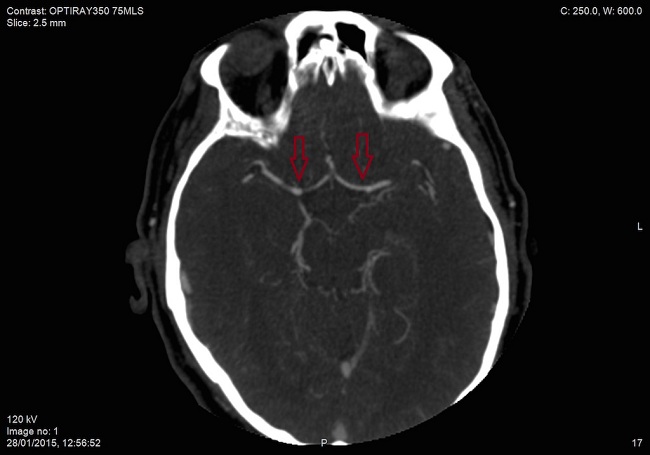 |
| Figure 1A: [CTA with MIP reconstruction]: Red arrows indicating normal sized MCA arteries; No signs of narrowing or obstruction |
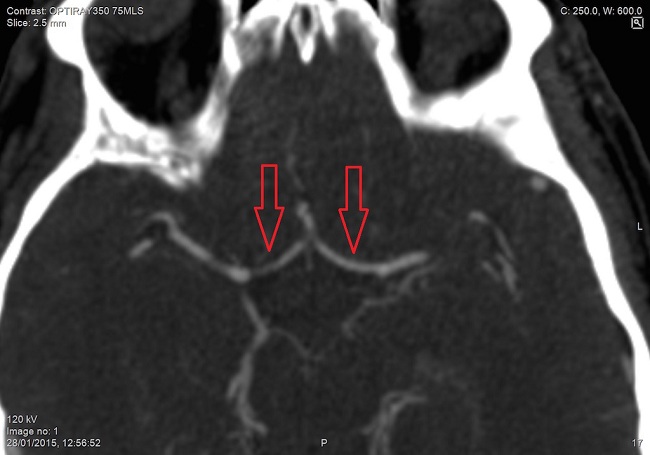 |
| Figure 1B: [CTA with MIP magnification of MCA arteries]: Red arrows indicating normal sized MCA arteries |
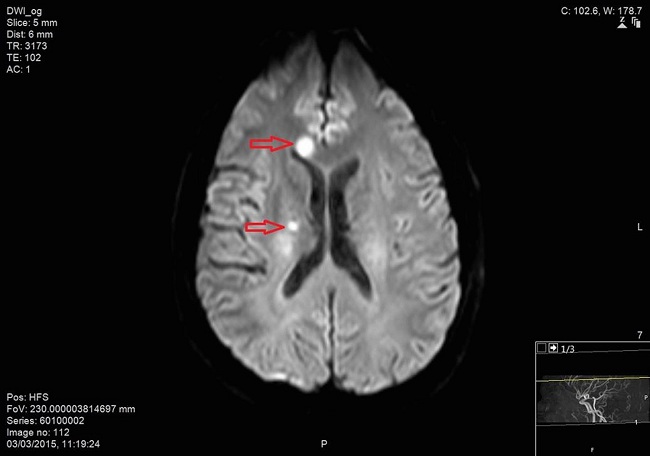 |
| Figure 2A: [MRI-DWI]: Well-defined right corpus callosum and right centrum semiovale infarction |
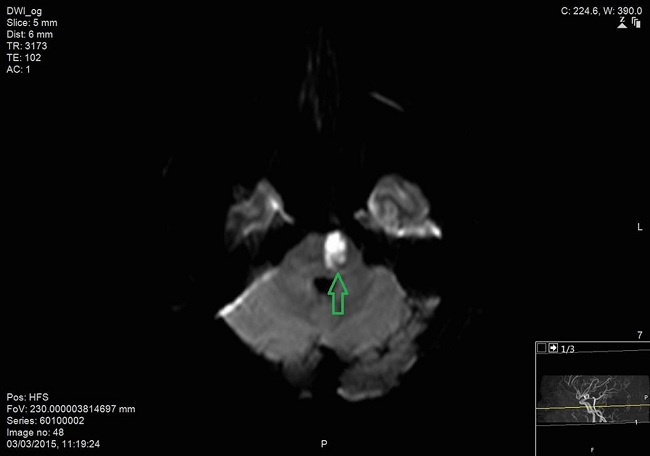 |
| Figure 2B: [MRI-DWI]: Moderate sized left pontine infarction |
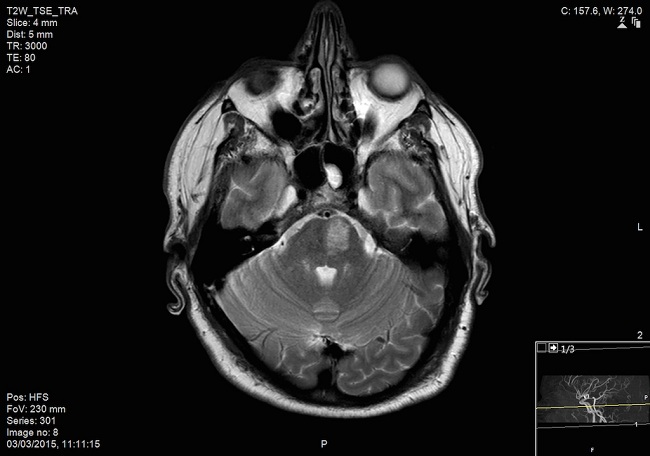 |
| Figure 2C: [MRI-T2]: Indicating left pontine infarction |
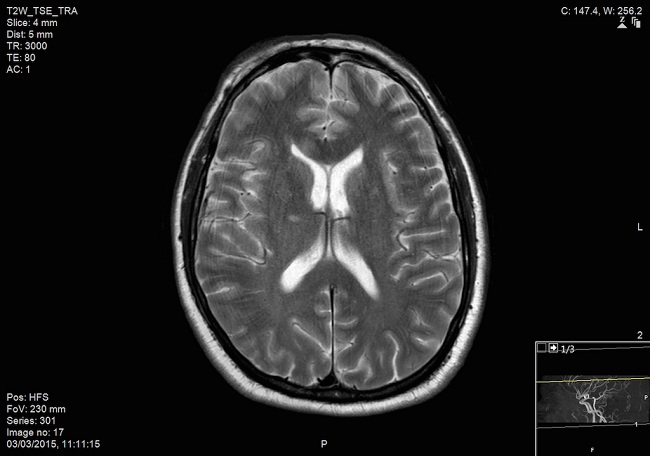 |
| Figure 2D: [MRI-T2]: Indicating right corpus callosum and right centrum semiovale infarction |
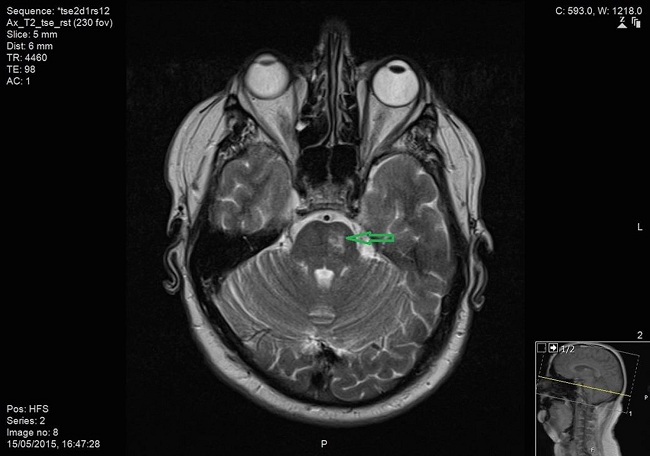 |
| Figure 3A: [MRI-T2]: Indicating resolving left pontine infarction |
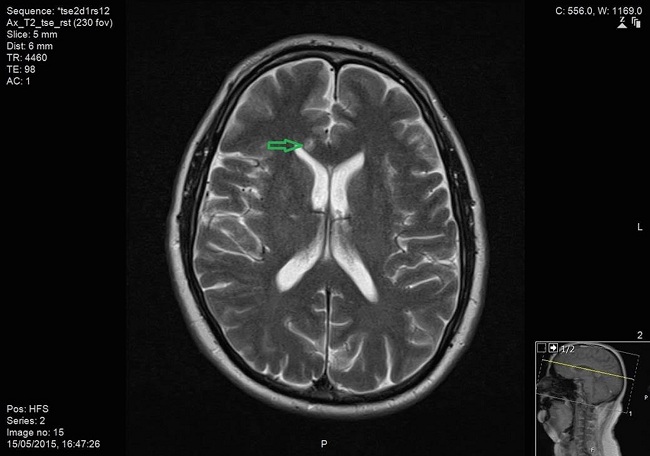 |
| Figure 3B: [MRI-T2]: Indicating resolving right corpus callosum infarction and resolving centrum semiovale infarction |
 |
| Figure 4: [MRI-T1 axial post contrast]: Showing enhancement of vessel walls of the left MCA, suggestive of intracerebral vasculitis (however, this is not a pathognomonic sign and can present in other intra-cerebral vasculitis) |
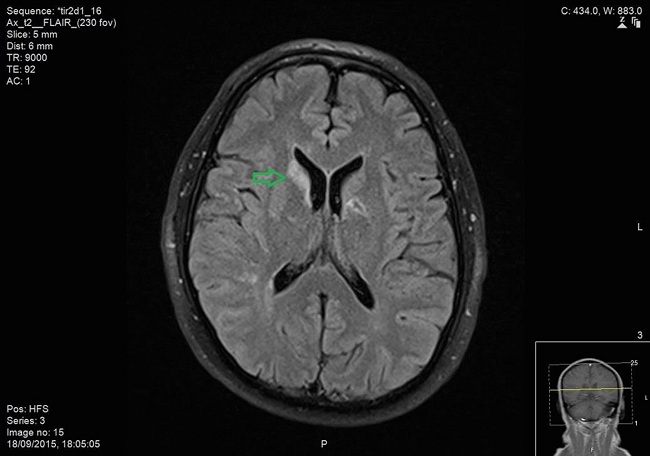 |
| Figure 5A: [MRI-T2 Flair]: Indicating acute to sub-acute ischemic infarctions in the head of the right caudate nucleus and the left internal capsule |
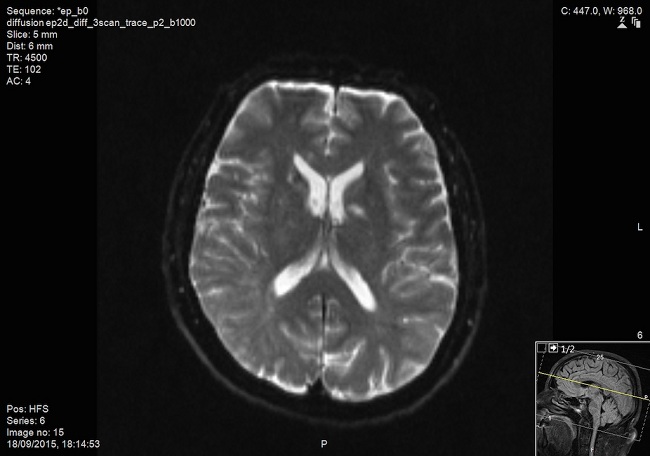 |
| Figure 5B: [MRI-DWI]: Indicating acute left internal capsule infarction |
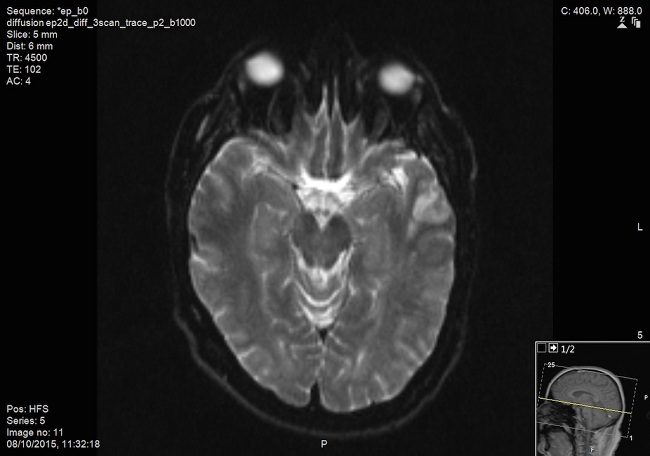 |
| Figure 6A: [MRI-DWI]: Indicating acute infarction in the left superior temporal gyrus (STG) |
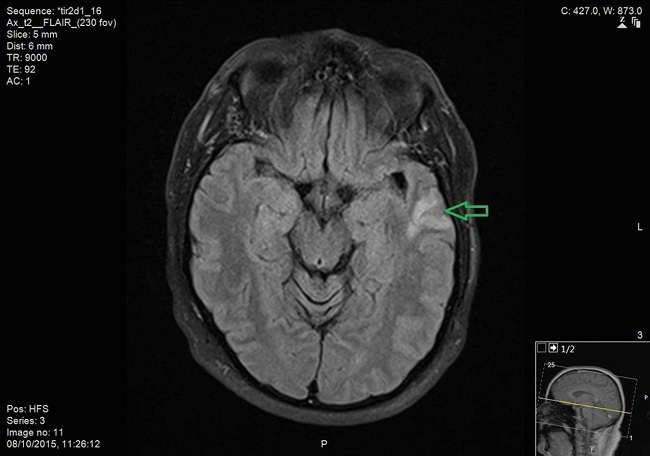 |
| Figure 6B: [MRI-T2 FLAIR]: Indicating infarction in the STG |
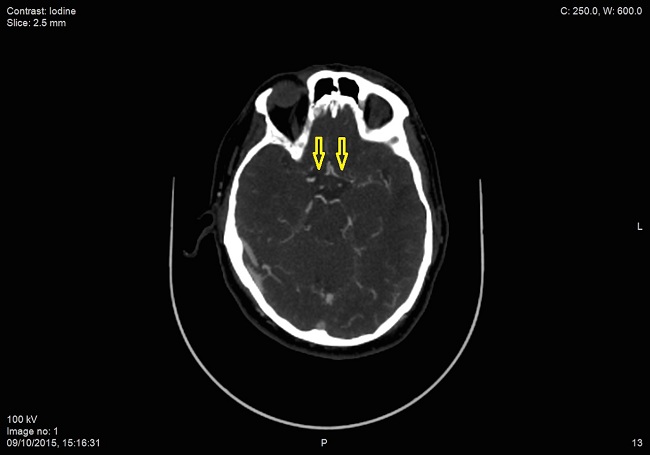 |
| Figure 7A: [CTA-MIP reconstruction]: Yellow arrows indicating a clear reduction in diameter of both MCA (in comparison with Figure 1A and 1B) |
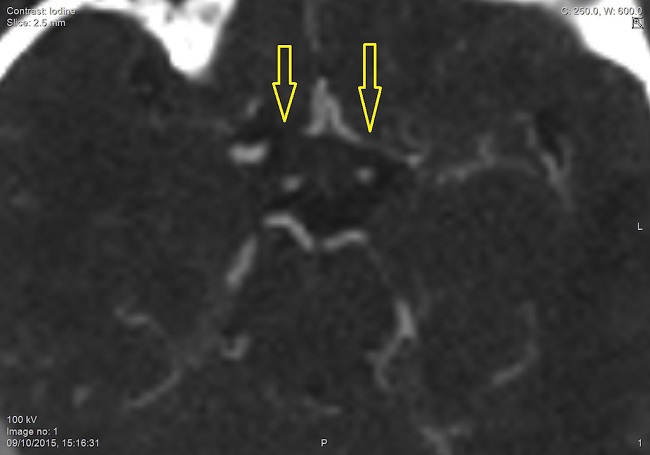 |
| Figure 7B: [CTA-MIP magnification of both MCAs]: Yellow arrows showing in a magnified view the reduction in size of both MCA (in comparison with Figure 1A and 1B) |
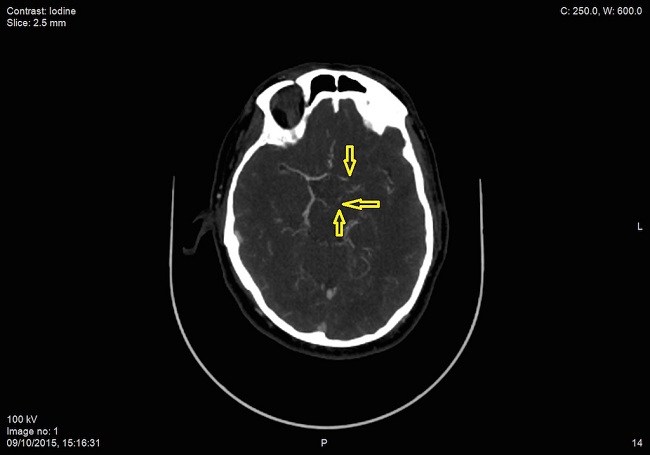 |
| Figure 7C: [CTA-MIP reconstruction]: Yellow arrows showing reduction in size of arteries from the circle of Willis (in comparison with Figure 1A and 1B) |
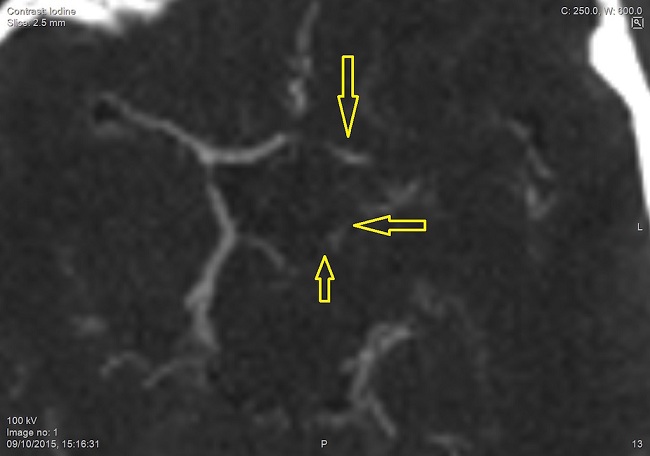 |
| Figure 7D: [CTA-MIP magnification of circle of Willis]: Yellow arrows showing in a magnified view the reduction in diameter of the arteries from the circle of Willis (in comparison with Figure 1A and 1B) |
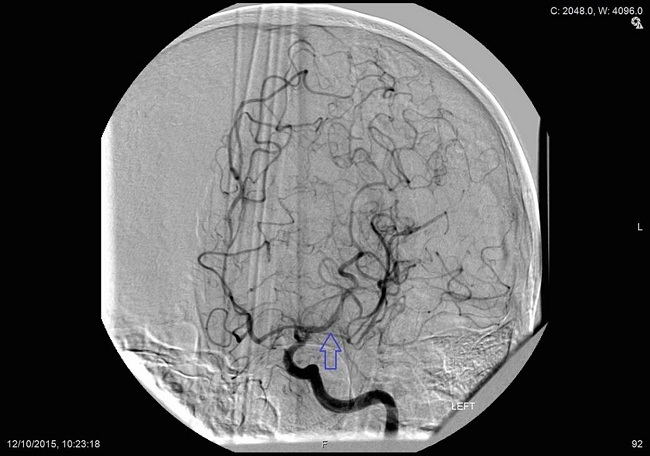 |
| Figure 8A: [DSA]: Blue arrow indicating a considerable reduction in diameter of the left MCA |
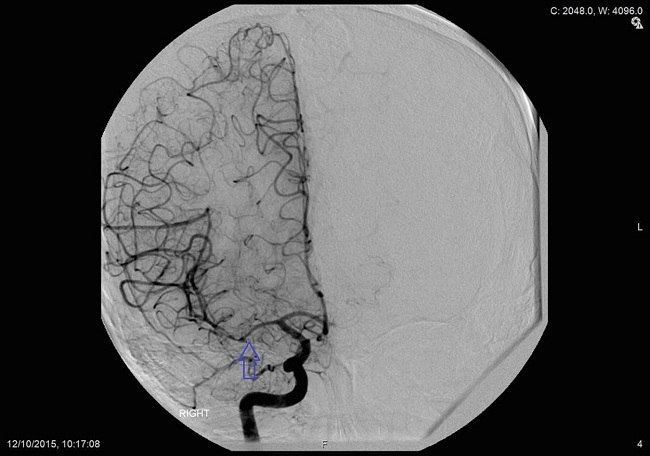 |
| Figure 8B: [DSA]: Blue arrow indicating a considerable reduction in diameter of the right MCA |
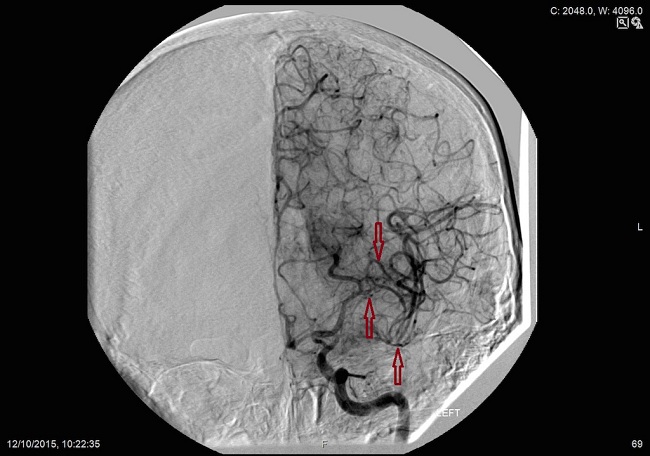 |
| Figure 8C: [DSA]: Red arrows indicating the classical “beading” of the intracerebral arteries. In this case, branches of the left MCA |
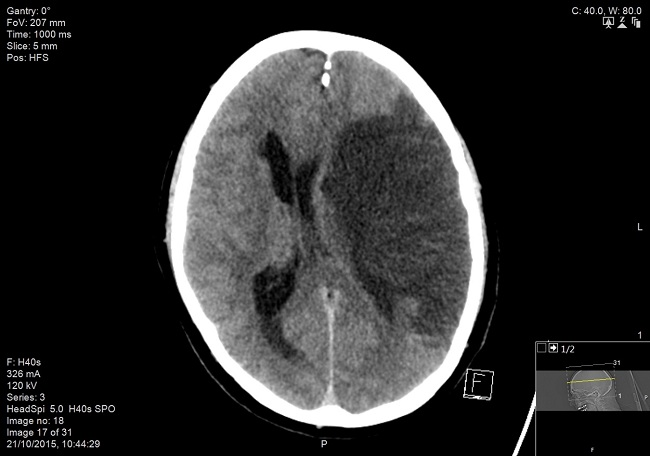 |
| Figure 9A: [CT-non contrast]: Left malignant MCA infarction with midline shift |
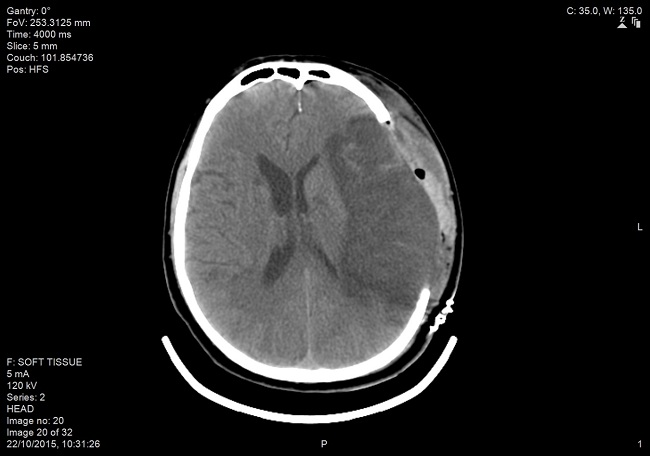 |
| Figure 9B: [CT-non contrast post hemicraniectomy] |
 |
| Figure 7A: [CTA-MIP reconstruction]: Yellow arrows indicating a clear reduction in diameter of both MCA (in comparison with Figure 1A and 1B) |
 |
| Figure 7B: [CTA-MIP magnification of both MCAs]: Yellow arrows showing in a magnified view the reduction in size of both MCA (in comparison with Figure 1A and 1B) |
 |
| Figure 7C: [CTA-MIP reconstruction]: Yellow arrows showing reduction in size of arteries from the circle of Willis (in comparison with Figure 1A and 1B) |
 |
| Figure 7D: [CTA-MIP magnification of circle of Willis]: Yellow arrows showing in a magnified view the reduction in diameter of the arteries from the circle of Willis (in comparison with Figure 1A and 1B) |
 |
| Figure 8A: [DSA]: Blue arrow indicating a considerable reduction in diameter of the left MCA |
 |
| Figure 8B: [DSA]: Blue arrow indicating a considerable reduction in diameter of the right MCA |
 |
| Figure 8C: [DSA]: Red arrows indicating the classical “beading” of the intracerebral arteries. In this case, branches of the left MCA |
 |
| Figure 9A: [CT-non contrast]: Left malignant MCA infarction with midline shift |
 |
| Figure 9B: [CT-non contrast post hemicraniectomy] |






































